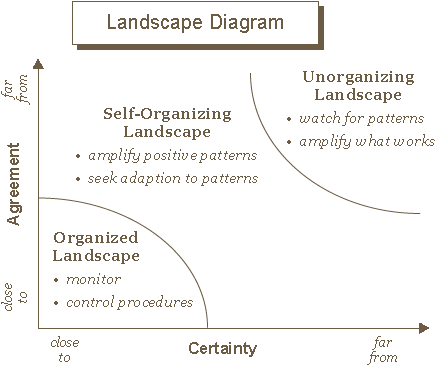Patterns for Change Part 1
October 7, 2010 6 Comments
|Graphic from Human Systems Dynamics Institute|http://www.hsdinstitute.org/about-hsd/what-is-hsd/faq-tools-and-patterns-of-hsd.html|
What do you do when you cannot control or predict? For many people I’m sure this question raises just a little bit of anxiety. After all, having some sense of autonomy and mastery is reported as being key to our mental well-being. And yet increasingly we find ourselves in complex and changing situations that are beyond our grasp and where the outcome is very much uncertain. Of course this is not the case with everything. Some of our work falls within the ordered realm. But how do we work outside of this tidy zone?
I’ve been enjoying Influencing Patterns for Change, a primer on human systems dynamics, which offers up some insights for how would be change agents can influence what otherwise may appear beyond their control. Authors Royce Holladay and Kristine Quade build upon the work of their mentor Glenda Eoyang to illustrate practical ways of working with complex human systems. First they differentiate between what they call the organized and unorganized zones of human systems (see image above). The first refers to those areas of activity where there is agreement and a high degree of predictability (think the payroll process). The latter refers to those areas that are more random and surprising (for example, when a new team comes together for the first time). In between lies the self-organizing zone, where the system begins to sort out and respond to its environment.
The sustainability of a system (organization, community) is characterized by the degree to which it can achieve some fit with its environment. In order to fit with more organized conditions, a system requires greater constraints to streamline and monitor activity and make it highly efficient. Rules, regulations, policies, and procedures conserve valuable energy. Activity in the unorganized zone must be met with fewer constraints, to make sense of new information and trends and to activate new thinking. In the self-organizing zone, to the extent that constraints are in place they aid with making meaning of and adapting to new conditions.
What all of this means is that it behooves change agents to consider where a situation falls on the landscape and therefore whether greater or fewer constraints would be more beneficial for the group, organization, community. But how to increase or decrease constraints especially in a situation that does not lend itself to control or predictability? That’s where paying attention to and attending to patterns comes in. More on that tomorrow.
6 Comments
Love this. Reminds me of the Cynefin Framework–how to understand the context you’re in, what’s known/knowable, etc. Looking forward to next installment!
Honey Bunches of Oats Original or with Almonds $2.85 each -$1/1 Post Honey Bunches Of Oats Cereal, Any =$1.85 each after coupon &q;oSutome post may contain my Affiliate links, please see my Disclosure
Yes, they certainly have been in conversation with Snowden. And I really appreciate the next step they take this, which I’ll talk more about tomorrow. I like how it helps to shift the debate from the tighter vs. more open conversation, as if one is innately better than the other.
Yes, we’ve been in touch with Dave Snowden and his work. These patterns also appear in the work of Brenda Zimmerman and Michael Patton in Getting to Maybe. We should also note that this model is a derivation of Ralph Stacey’s early work in Managing the Unknowable–another wonderful guide to seeing and influencing patterns in human systems (though in his recent work, Ralph disputes the existence of “systems”). Many of us try to find categories to build meaning into our otherwise overwhelming experience. Royce and Kristine in Patterns explain very well why we choose this particular model to navigate the complexities of human systems dynamics. It leads you quickly to options for action–Where are you now? Where do you want to be? How do you get there? All this in full knowledge that you can neither predict nor control outcomes.
Thank you, Glenda, for your comment and your contribution to my and our work. I look forward to sharing the Landscape and CDE Model with others and sending them your way. I appreciate the practical orientation of Royce and Kristine’s book. Maps on nicely to what many of us are doing intuitively and helps us to take it the next step – making the invisible! And as you say, not with the expectation that we can control or predict, but that over time, like good permaculture gardeners, we can support the regenerative capacity of a system that includes our interests!